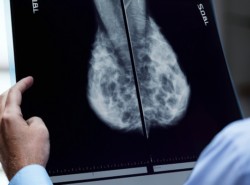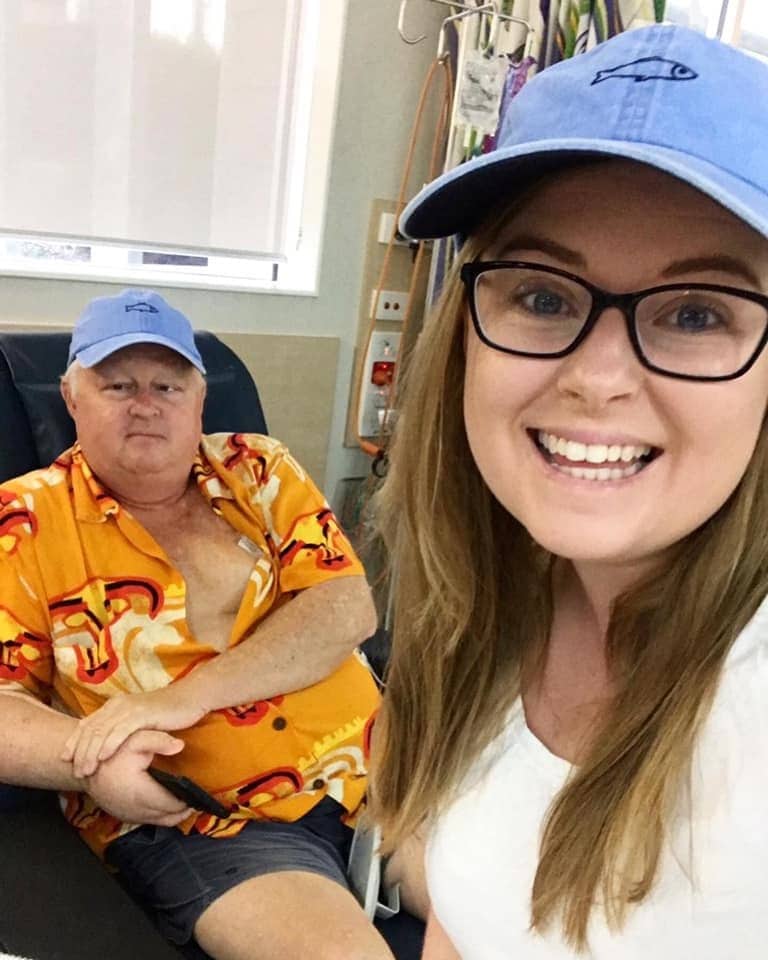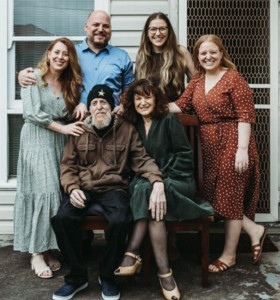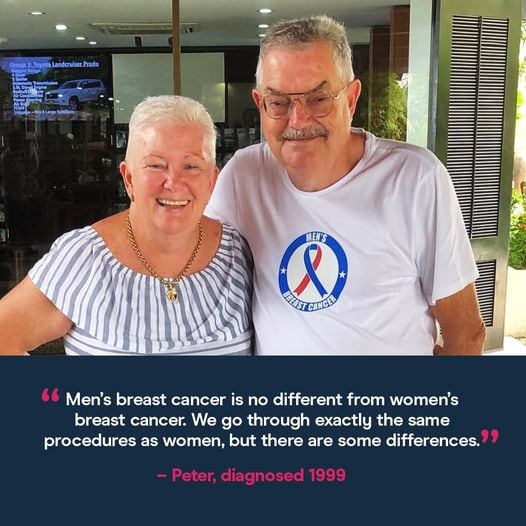
Breast cancer in men
Table of Content
- Can men get breast cancer?
- Symptoms of breast cancer in men
- Risk factors for breast cancer in men
- How to prevent male breast cancer
- Male breast cancer screening
- Diagnosis of breast cancer in men
- Types of Breast Cancer in Men
- Treatment of breast cancer in men
- Can male breast cancer be cured?
- Getting support
- Loved ones of male breast cancer patients
- Resources for men
Breast cancer is often thought of as a disease that only affects women. Although breast cancer is more common in women, men can get breast cancer too.
In Australia, about one in 500 men will be diagnosed with breast cancer in their lifetime.
Regardless of gender, the National Breast Cancer Foundation’s vision is of a world where every single life is saved from breast cancer. Because men can also be diagnosed with breast cancer, it’s just as important for men, as it is for women, to speak to their doctor without delay if they notice any new or unusual breast changes.
On this page we will look at the symptoms and risk factors of male breast cancer, and how breast cancer is diagnosed and treated in men. We also provide information on the support available for men with breast cancer, their carers and loved ones.
Alice’s story
“Breast Cancer does not discriminate! Men can get breast cancer too! I hope that spreading this awareness will help men have a better chance of fighting this horrible disease, I sure wish my dad knew earlier! Ladies AND Gentlemen make sure you check your breasts,” Alice, pictured with her late dad Rhod, who was diagnosed with breast cancer in 2015
DONATE TO BREAST CANCER RESEARCH
Can men get breast cancer?
It may come as a surprise to learn that men can develop breast cancer. Though it is uncommon, breast cancer does occur in men. In Australia, about 1% of breast cancer cases each year are in men.
Men, like women, have breast tissue. Although women have a lot more breast tissue than men and are more likely to develop breast cancer, cancer can also develop in male breast tissue.
Over 200 men are diagnosed with breast cancer each year in Australia, and the majority of these men will be diagnosed after the age of 50. With an aging population, it is likely that the number of men diagnosed with breast cancer will continue to increase.
Ebony’s story
“Breast cancer wasn’t something that was on my Dad’s radar and it was completely unexpected. This has opened up conversations with people, as they were surprised at the diagnosis of breast cancer for our Dad, thinking it was a female only disease. It shows us that more awareness needs to be brought to the attention of people. In April 2022, our loving Dad passed away from breast cancer, after battling through this condition for over a year and a half. He was a true inspiration to us all, he fought his battle with real strength and dignity. Our Dad loved to help and talk to others, so we wanted to fundraise and share our story as a way to honour him and help others in the same situation.” Pictured Ebony, her family and her Dad, Daniel.
↑ Go to the Table of Contents
Symptoms of breast cancer in men
It is important that men speak with their doctor as soon as possible if they notice any new or unusual breast changes.
Symptoms of breast cancer in men are similar to those that women experience. These include:
- A lump in the breast, such as a painless lump close to the nipple.
- A change in the skin colour, texture and appearance of the breast, such as thickening, swelling or dimpling of the skin
- A change in the shape and appearance of the nipple or pectorals (muscles at the front of the chest)
- Discharge from the nipple
- Pain in the breast region
- Swollen lymph nodes (glands) under the arm.
It is possible that the above symptoms arise due to reasons unrelated to breast cancer. However, Cancer Australia recommends that men who detect any new or unusual breast changes see their doctor without delay. If the changes are caused by cancer, finding breast cancer early improves the chances that it can be treated successfully.
Risk factors for breast cancer in men
While it is difficult to determine the exact causes of male breast cancer, there are some factors that are linked to an increased risk of the disease. Although these risk factors increase your risk of breast cancer, it does not mean that you will develop breast cancer. Moreover, having no known risk factors does not guarantee that you will never develop breast cancer.
Common risk factors for breast cancer in men include:
Age
Similar to women, men are much more likely to develop breast cancer as they get older. The majority of men (more than 90%) are diagnosed at or after age 50.
Strong family history
A strong family history of male or female breast cancer can increase the risk of men developing breast cancer. However, most men who develop breast cancer do not have a strong family history. If you are concerned that you may have an increased risk of breast cancer due to family history, please consult your doctor.
BRCA gene mutations
Men with an inherited mutation (defect) in the BRCA2 gene, and to a lesser extent the BRCA1 gene, are at an increased risk of breast cancer. However, only a minority of breast cancers are explained by inherited mutations, and not everyone with a faulty gene will develop breast cancer. If you are concerned about your breast cancer risk due to genetic susceptibility, please speak with your doctor.
Hormone imbalances
In addition to the male hormone testosterone, all men produce small amounts of the female hormone estrogen in their bodies. Men who produce higher than normal levels of estrogen may have an increased risk of breast cancer.
How to lower the risk of male breast cancer
While there is no known way to completely prevent male breast cancer, healthy lifestyle choices can help reduce the risk of a number of cancers, including breast cancer in men. These lifestyle choices include:
- Limiting alcohol consumption
- Keeping a healthy weight
- Being physically active
- Not smoking
- Eating a balanced diet
Male breast cancer screening
In Australia, breast screening for men is not recommended. However, if you are concerned about any new or unusual changes in your breast, please speak to your GP. Finding breast cancer early improves the chances that it can be treated successfully.
Diagnosis of breast cancer in men
Your doctor will investigate any new or unusual breast changes using a variety of diagnostic tests. These tests are the same as the ones used to study breast changes in women. They may include:
- Clinical breast examination, and taking a complete personal medical history.
- Mammogram – a low level x-ray of the breast. Though mammograms are not recommended for male breast cancer screening in Australia, they can be used to help diagnose breast cancer in men.
- Ultrasound – an imaging technique that uses sound waves to look at breast changes. It may help to determine whether a lump found in the breast is a fluid-filled cyst (which is unlikely to be cancer) or solid (which may require further testing to ensure it is not cancer).
- Biopsy – your doctor may recommend a biopsy if an abnormality is found during clinical examination and/or imaging tests. A biopsy involves removing a small sample of tissue and a specialist examining the sample under microscope.
If you are diagnosed with breast cancer, your doctor may send you for further tests to help determine the extent of cancer spread in the body. Additional tests will be done to determine the molecular characteristics of the tumour, such the cancer’s hormone receptor status. These tests will help you and your doctors decide on the best treatment options.
Types of breast cancer in men
The types of breast cancer that affects men are similar to those found in women. Common types of male breast cancer include:
- Invasive ductal carcinoma (IDC) – this is the most common type of breast cancer found in men. It occurs when cancer cells grow outside the duct and spreads into nearby breast tissue. If untreated, the cancer cells can spread (or metastasise) to other parts of the body.
- Invasive lobular carcinoma (ILC) – this type of breast cancer occurs when the cancer cells grow outside of the lobules and spreads into nearby breast tissue. It can also metastasise if not treated.
- Ductal Carcinoma In situ (DCIS) – this breast disease occurs when cells within the duct are abnormal. The cancer cells are contained within the ducts and have not spread into nearby tissue. It can be referred to as a non-invasive breast cancer, although DCIS may lead to invasive breast cancer over time.
Men can also be diagnosed with less common forms of breast cancer, such as Paget’s disease of the nipple, or inflammatory breast cancer.
George’s story

George with his grandchildren
“When I first heard I had breast cancer it came as quite a shock. Like most guys, I was unaware men could get this disease. Fortunately, I was diagnosed in the early stages and didn’t require chemotherapy or radiation,” George, diagnosed 2007.
George is the co-founder of Men Get Breast Cancer Too Forum, which aims to raise awareness of male breast cancer.
DONATE TO STOP DEATHS FROM BREAST CANCER
Treatment of breast cancer in men
If you are diagnosed with male breast cancer, the treatment that is recommended for you will depend on many different factors, including the type of breast cancer that you have, the extent of cancer spread, your health and personal preferences.
Treatment options for men with breast cancer include:
- Surgery – Most men diagnosed with breast cancer will usually have surgery as part of their treatment. Mastectomy (where the whole breast is removed) is commonly used to treat men with breast cancer. Breast-conserving surgery (where only the part of the breast containing cancer is removed) is usually not a suitable option for men because they have little breast tissue. However, it may be an option for small cancers. During surgery, one or more lymph nodes in the armpit may be removed to help determine cancer spread, which helps to plan treatment.
- Radiotherapy (also known as radiation treatment) – is the use of targeted radiation to kill cancer cells. Not all men with breast cancer will need radiotherapy. However, it is usually recommended after breast-conserving surgery to eradicate any cancer cells that remain in the breast, chest muscles or armpit. It can also be recommended after mastectomy, especially if there is cancer found in the lymph nodes or if the cancer is large.
- Hormone therapy (also called endocrine therapy) – uses drugs to treat hormone receptor positive breast cancers (cancers with oestrogen or progesterone receptor). The majority of male breast cancers are hormone receptor positive, making them more likely to respond to hormone therapy.
- Chemotherapy – uses drugs to destroy cancer cells within the body, including cancer cells that may have started spreading outside the breast. Not all men will require chemotherapy, but it may be recommended after surgery, if cancer is found in the lymph nodes. If the tumour is large, chemotherapy may also be recommended before surgery (this is called neoadjuvant chemotherapy) to reduce the size of the tumour and make it easier to remove during surgery.
- Targeted therapy – are drugs used to treat certain types of breast cancer. For example, Herceptin is commonly used to treat HER2-positive breast cancers.
Can male breast cancer be cured?
Most men diagnosed with breast cancer can be treated successfully. Although the five-year survival rate of men diagnosed with breast cancer is around 5% less than women, more than 85% of men who are diagnosed with breast cancer will survive five years or more after their diagnosis. In the last three decades, the mortality rate from male breast cancer in Australian men has halved.
However, if cancer has spread from the breast to other parts of the body, it often becomes more difficult to treat. Cancer that has spread to other parts of the body is called secondary, advanced or metastatic breast cancer. You may also hear it referred to as stage 4 breast cancer.
Being diagnosed with metastatic breast cancer can be confronting and devastating. While there is currently no cure for metastatic breast cancer, it is possible to control it with treatment – sometimes for many years. Treatment for metastatic breast cancer aims to control the growth and spread of the cancer, relieve symptoms and maintain a good quality of life for as long as possible.
NBCF is committed to Zero Deaths from breast cancer for both male and female patients. Learn more about our funded projects investigating different ways to improve breast cancer treatment here.
Getting support
Because breast cancer is frequently seen as a ‘women’s disease’, some men may find it difficult or embarrassing to discuss their diagnosis. Breast cancer may also leave some men feeling surprised, anxious, depressed or angry. Men may feel self-conscious or worried about their masculinity.
As there tends to be little awareness of male breast cancer in the general population, it can be difficult to connect with other men in a similar situation. This can leave men feeling isolated and alone.
If you are a man diagnosed with breast cancer looking for support, Cancer Council and Breast Cancer Network Australia have further resources to provide emotional and practical support for men affected by cancer, including information and personal stories about men diagnosed with breast cancer.
Loved ones of male breast cancer patients
The news and implications of a breast cancer diagnosis are not only challenging for the man going through it, but also for those closest to them, such as the man’s partner, family and close friends. The man’s loved ones may experience a range of emotions, such as shock, fear, worry, powerlessness and may not know what to say. There may be concerns about finances or changes in the dynamics of relationships; breast cancer treatment can also impact on the man’s sexual wellbeing.
If you are man diagnosed with breast cancer, you may want to start by telling your family and a few close friends about your diagnosis, which may help you become familiar with other people’s reactions. After you feel more comfortable and confident talking about your diagnosis, you may wish to let others know.
Further information and support are also available for carers of men diagnosed with breast cancer.
Resources for men
Breast Cancer Network Australia (BCNA) Men Get Breast Cancer Too booklet – This booklet is written for men with breast cancer. It provides information on male breast cancer, its treatment, and issues men may face after diagnosis. It also includes information for support available for men with breast cancer. BCNA also has a dedicated webpage and an episode in their breast cancer podcast focussed on breast cancer in men.
Look Good Feel Better – is a free nationwide program that teaches cancer patients to manage appearance-related side effects caused by cancer treatment, which can help them to feel more positive and in control. The program provides workshops specifically tailored for men.
Cancer Connect (13 11 20) – A free service run by the Cancer Council that is available nationwide in Australia. People diagnosed with cancer can connect with a specially trained volunteer who has had a similar cancer experience.
Words: Francesca Brook
Reviewed by: NBCF Research team
Yes. In Australia, about one in 700 men will be diagnosed with breast cancer in their lifetime. Nearly 200 men Australian men will be diagnosed with breast cancer each year. Although this amounts to fewer than 1% of breast cancer cases each year, men have poorer outcomes with the five-year survival rate for men diagnosed with breast cancer currently at around 86%, 5% less than women.
Symptoms of breast cancer in men are similar to the symptoms of breast cancer in women. These include a lump in the breast, changes in the texture or skin colour in the breast area or changes to the nipple. It is important that men speak with their doctor if they notice any new or unusual breast changes. See here for more symptoms of breast cancer.
Though it’s uncommon, men can be diagnosed with breast cancer. The main reasons that breast cancer is more common in women is because 1) women have more fully formed breast tissue including milk-producing glands, the most common site where breast cancer begins and 2) breast cells in women are exposed to higher levels of the hormones estrogen and progesterone, which are important for the growth of breast tissue but can also stimulate the growth of breast cancer cells.
There is no way male breast cancer can be completely prevented but healthier lifestyle choices can help to decrease the risk of developing a variety of cancers in men, including breast cancer. Keeping a healthy diet, not smoking and limiting alcohol are all ways cancer risk can be reduced.
In most cases, male breast cancer can be treated successfully. Approximately 86% of men who are diagnosed in Australia will live for five years or more after their diagnosis. However, if the cancer has spread to other organs (also known as stage 4 or advanced breast cancer), the disease becomes more difficult to treat.
Related Research




